Centrolenidae
Glass Frogs
David Cannatella- Centrolene
- Hyalinobatrachium
- Cochranella
Introduction
Glass frogs derive their name from the observation in that several the skin is almost transparent, and once can see the internal organs, and even observe the heart beating in some species. The Glass Frogs are a large group of rather similar species. They are mostly arboreal, living high in trees overhanging mountain streams in Mexico, Central, and South America. With the exception of Centrolene gekkoideum most species are small, about 20-30 mm long. Until the recent work of Ruiz-Carranza and Lynch (1991), all of the small species were called Centrolenella; that name is no longer used.
The call of Glass Frogs is a high peep or whistle. In some species, a single individual seems to initiate a chorus, in which a wave of calls seems to travel along the stream. Centrolenids lay their clutches of eggs on vegetation, usually several meters above a stream (one high montane species, Centrolene buckleyi, uses bromeliads to hide their eggs). When the eggs hatch, the tadpoles fall into the water; or, if they miss the water, they use their muscular tails to flip themselves into the water. The tadpoles generally burrow into the stream substrate. In some species the males position themselves over the egg mass, apparently guarding it from predators, including "frog flies" which lay their eggs in the frog's egg mass. The developing fly larvae are known to parasitize and destroy clutches of eggs (Villa and Townsend, 1983).
Because they inhabit high montane streams, glass frogs are not collected casually; of the 64 species listed in Frost (1985), only 23 were described before 1960, and many more have been described since 1985. The exploration of new streams along the Andes of South American almost certainly yields new species.
Geographic Distribution
The distribution of living members of the family Centrolenidae is indicated in red.
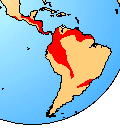
Discussion of Phylogenetic Relationships
Centrolenidae was defined by Ford and Cannatella (1993) as a node-based name for the common ancestor of Cochranella, Hyalinobrachium, and Centrolene (taxa included in Ruiz-C. and Lynch [1991]) and all its descendants. The oft-cited synapomorphy for Centrolenidae is the fusion of the astragalus and calcaneum (Duellman and Trueb, 1986; Lynch, 1973); this feature is convergent with that in Pelodytes. Ruiz-Carranza and Lynch (1991) listed this synapomorphy and additionally, a dilated medial process on the third metacarpal, T-shaped terminal phalanges, and eggs deposited out of water. The last two of these are present in other groups, and require corroboration by a better-resolved phylogeny of Neobatrachia. Examination of skeletons of more than 40 species by Cannatella suggests that the presence of a process on the third metacarpal is a well-corroborated synapomorphy.References
Click here for general list of references
Title Illustrations

1. Hyalinobatrachium fleischmanni, Costa Rica; photo © 1995 David Cannatella
2. Hyalinobatrachium fleischmanni eggs; photo © 1995 David Cannatella
3. Hyalinobatrachium oyampiensis; photo © 1995 David Cannatella
| Copyright |
© 1995 David Cannatella

|
|---|
| Copyright |
© 1995 David Cannatella

|
|---|
| Copyright |
© 1995 David Cannatella

|
|---|
About This Page
David Cannatella

University of Texas, Austin, Texas, USA
Correspondence regarding this page should be directed to David Cannatella at
Page copyright © 1995 David Cannatella
 Page: Tree of Life
Centrolenidae. Glass Frogs.
Authored by
David Cannatella.
The TEXT of this page is licensed under the
Creative Commons Attribution License - Version 3.0. Note that images and other media
featured on this page are each governed by their own license, and they may or may not be available
for reuse. Click on an image or a media link to access the media data window, which provides the
relevant licensing information. For the general terms and conditions of ToL material reuse and
redistribution, please see the Tree of Life Copyright
Policies.
Page: Tree of Life
Centrolenidae. Glass Frogs.
Authored by
David Cannatella.
The TEXT of this page is licensed under the
Creative Commons Attribution License - Version 3.0. Note that images and other media
featured on this page are each governed by their own license, and they may or may not be available
for reuse. Click on an image or a media link to access the media data window, which provides the
relevant licensing information. For the general terms and conditions of ToL material reuse and
redistribution, please see the Tree of Life Copyright
Policies.
Citing this page:
Cannatella, David. 1995. Centrolenidae. Glass Frogs. Version 01 January 1995 (under construction). http://tolweb.org/Centrolenidae/16952/1995.01.01 in The Tree of Life Web Project, http://tolweb.org/




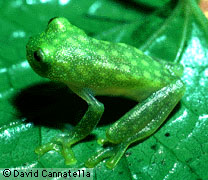
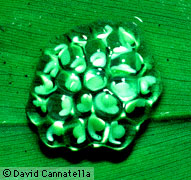

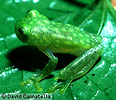
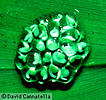



 Go to quick links
Go to quick search
Go to navigation for this section of the ToL site
Go to detailed links for the ToL site
Go to quick links
Go to quick search
Go to navigation for this section of the ToL site
Go to detailed links for the ToL site